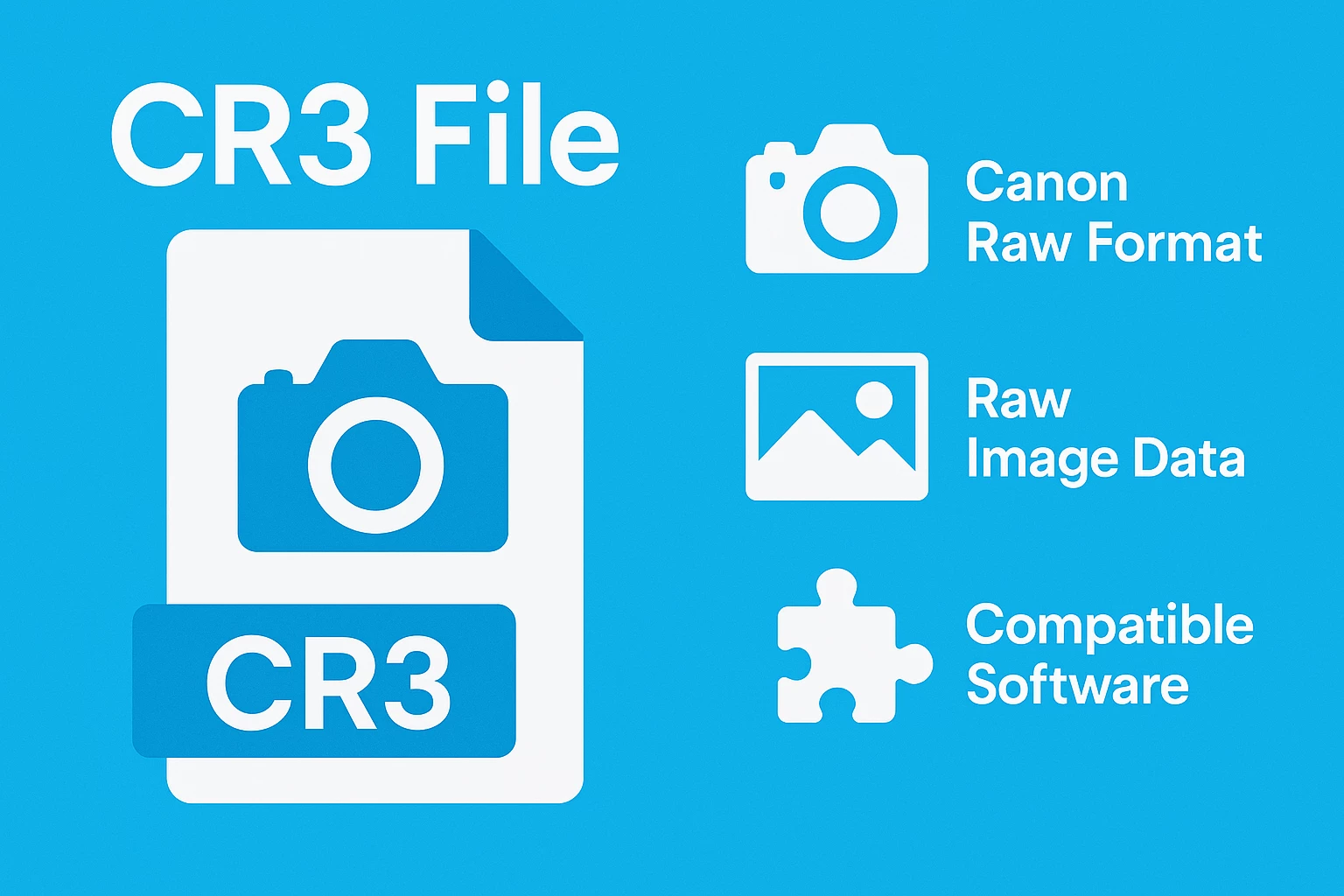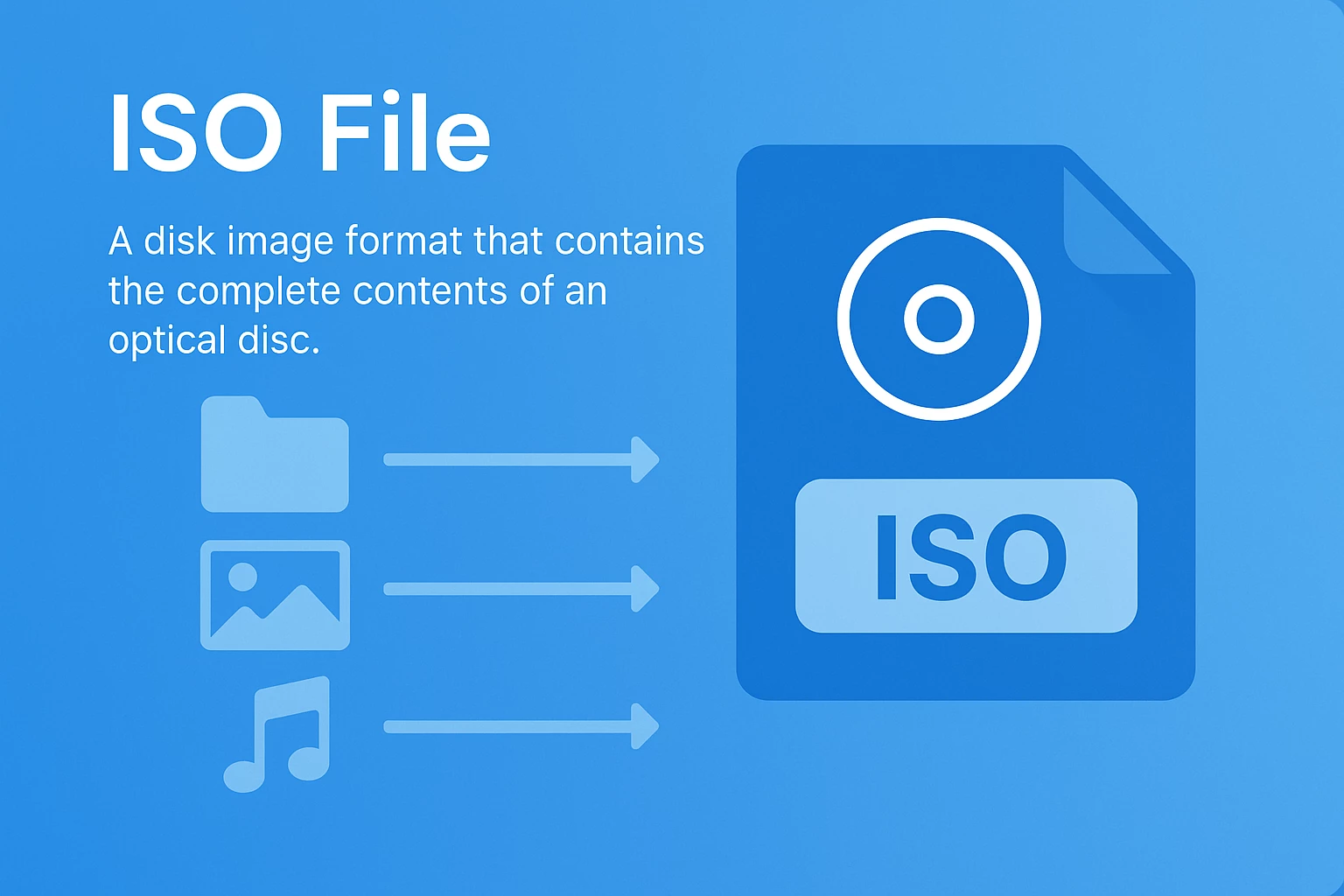
What Is an ISO File? The Ultimate Guide for 2025
ISO files have become a quiet standard for storing, sharing, and replicating large sets of digital data. I often use them when creating system backups, bootable drives, or distributing software installations, and over time, they’ve proven to be one of the most dependable formats for keeping data organized and intact.
An ISO file is essentially a digital copy of a physical disc: a complete image that preserves the structure and content of a CD, DVD, or Blu-ray. Instead of holding individual files, it stores everything in a single archive that mirrors the original disc exactly.
ISO remains relevant in 2025 because of its adaptability and continued usefulness across systems. Modern operating systems can mount and run ISO files directly, removing the need for physical discs.
Stick with me, and I’ll walk you through everything from creating and mounting ISO files to keeping them secure and properly verified in 2025.

Common Use Cases of ISO Files in 2025#
ISO files have evolved far beyond their original purpose of storing disc images. In 2025, they will serve as an essential tool for professionals and everyday users who need secure, portable, and easily replicable file structures. I use ISO files frequently in both personal and work settings because they simplify data handling across devices and platforms.
One of the most common uses is operating system installation. ISO files make it easy to create bootable drives for Windows, macOS, and Linux. Instead of relying on physical discs, I can install or repair systems directly from a USB or virtual drive. It saves time and ensures faster setup for new devices.
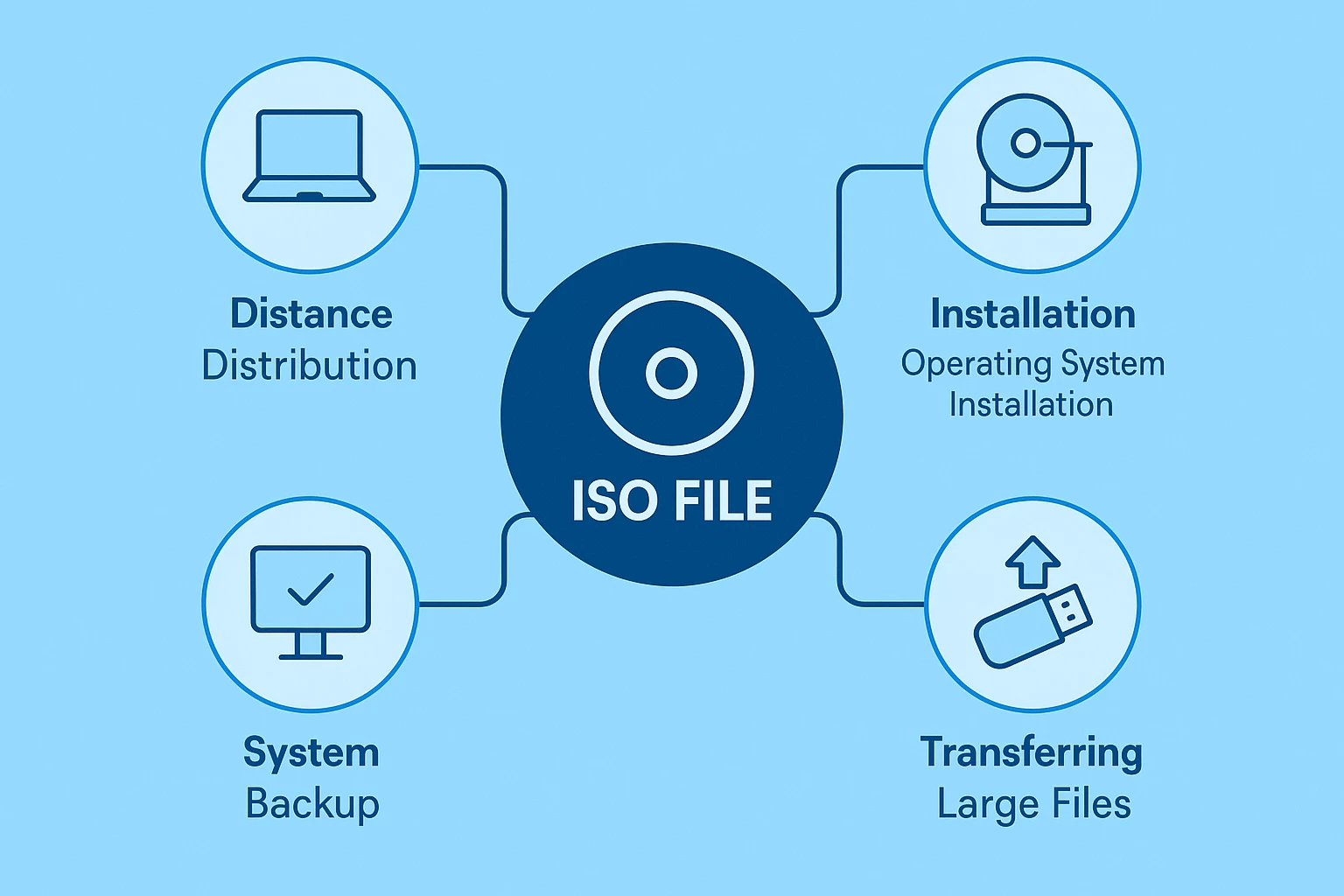
ISO files are also widely used for software distribution and archiving. Developers package large programs, games, or system images into a single ISO to keep file integrity intact. I often store older versions of applications in ISO format, knowing they remain unchanged and are easy to retrieve later.
Another growing use is data backup and digital preservation. Many companies use ISO files to archive entire projects, DVDs, or corporate documentation in one secure image. It’s also useful for personal backups, letting me store everything from video collections to installation media in an organized format.
In 2025, ISO continues to play a key role in virtualization, cloud storage, and cybersecurity workflows. Its ability to maintain exact file structures while remaining easy to mount and access keeps it an indispensable format for both professional and everyday users.
Convert ISO to Other Formats with MConverter
How to Create an ISO File#
Creating an ISO file is one of the simplest ways to organize large sets of data, replicate discs, or store software safely. I often create ISOs to archive my projects, prepare installation media, or move large folders without losing structure.
Similarly, the process has become faster in recent years, and every major operating system now supports ISO creation through built-in or third-party tools.
Before I begin, I make sure the files I’m converting are clean and properly arranged. Once the folder, disc, or drive is ready, I choose the right tool depending on what I’m working on: system images, backups, or custom software builds.
Some tools prioritize speed, while others focus on detailed control over boot and compression settings.
Using Built-in Tools (Windows, macOS, Linux)#
Modern operating systems make ISO creation straightforward.
On Windows, PowerShell or File Explorer utilities can generate an ISO from folders or discs with a few clicks. Windows 11 even allows mounting and burning ISOs natively.
On macOS, Disk Utility handles the process reliably as I select a drive or folder, choose “New Image,” then convert the resulting DMG file to ISO format.
On Linux, I usually rely on the dd command or Brasero, both of which can create ISOs directly from drives or directories.
Also read: What Is an MP4: Everything You Need to Know
Third-Party Software (PowerISO, Rufus, UltraISO, ImgBurn)#
When I need more flexibility, I use professional tools such as PowerISO, Rufus, UltraISO, or ImgBurn. These programs provide deeper control over every step of ISO creation. I can define boot sectors, select file system types, set volume labels, and include hidden partitions for specific system requirements.
PowerISO and UltraISO are great for detailed customization. They allow me to edit an existing ISO, add or remove files, and save the updated image without rebuilding it from scratch.
In need of bootable USB creation, Rufus remains one of the fastest and most reliable tools. It automatically detects the correct settings based on the target operating system.
ImgBurn, although older, still performs well when I need to burn and verify images for archival purposes.
Each program has its strengths, but they all aim to keep ISO files clean, stable, and fully compatible across systems. I choose the one that matches the project’s scale, whether I’m backing up files or building a full installation image.
Creating an ISO from a DVD/CD#
Backing up discs remains one of the most reliable ways to use ISO creation. I insert the original DVD or CD, launch an imaging tool, and choose “Create Image.” The program reads each sector of the disc, preserving menus, boot data, and file structure exactly as found on the source.
Consequently, the process proves valuable when protecting software installers, media collections, or recovery materials in digital form.
Rare or aging discs benefit the most from conversion. Storing the resulting ISO in cloud storage or on an external drive eliminates concerns about scratches, loss, or physical damage over time.
Related article: What Is a Zip File? Everything You Must Know
Creating ISO from Folder or USB Drive#
When dealing with folders or USB drives, ISO creation offers a straightforward way to merge numerous files into a single, organized archive. I select the source folder, assign a name to the new image, and start the conversion.
Within a short time, every file is compressed into a structured image that’s easy to move, upload, or mount whenever needed.
Moreover, it works perfectly when sharing extensive projects, client materials, or software libraries that must remain structured. The ISO format keeps every directory and filename intact, ensuring nothing shifts or breaks.
Also, it suits firmware distribution and installation packages that must function consistently across various systems.
How to Open or Mount an ISO File#
Mounting an ISO file lets me use it just like a physical disc without needing to burn it. I do it constantly when testing new software, installing operating systems, or accessing archived backups. Instead of wasting time with DVDs or USBs, I can double-click an ISO and have it ready to use within seconds.
Obviously, the best part is that every major operating system now includes built-in support for mounting ISO files, making the process effortless and consistent.
Once mounted, the ISO appears as a new drive on the computer. I can browse it, copy files, or run installations directly from it. When I’m done, I simply unmount or eject it to close the virtual drive.
Below are the methods I use most often across Windows, macOS, and Linux, along with a few reliable virtual drive tools that make handling ISO files even smoother.
Related article: What Is an OGG File? Audio Format Explained
On Windows (File Explorer, Mount option, PowerShell)#
On Windows, opening an ISO takes just a few clicks. I right-click the ISO file and select “Mount.” Within seconds, the system assigns a drive letter and opens the contents in File Explorer. From there, I can copy files, run installations, or extract the data as needed.
If the Mount option doesn’t appear, double-clicking the file usually works. Windows automatically detects the ISO and mounts it as a virtual drive. When finished, unmounting is simple; I right-click the drive and select “Eject.”
For automation or system management, I sometimes use PowerShell. The command “Mount-DiskImage -ImagePath "C:\path\to\file.iso” mounts the image instantly, while “Dismount-DiskImage -ImagePath "C:\path\to\file.iso”
removes it safely.
Ultimately, PowerShell makes it easy to script the process when managing multiple ISO files or deployment tasks.
On macOS (Disk Utility, Terminal)#
macOS handles ISO mounting just as smoothly. I open Disk Utility, go to the File menu, and choose Open Disk Image. Once selected, the system mounts the file and shows it in Finder like an external drive. I can then drag files, open installers, or verify the image without converting it.
For quick command-line work, I use Terminal. Running “hdiutil mount ~/Downloads/filename.iso” mounts the image instantly, and “hdiutil eject /Volumes/ISOName” unmounts it when I’m done. I like this method because it’s fast and doesn’t require any additional apps.
As well as, macOS remembers the most recently mounted images, which makes remounting previously used ISOs much easier.
On Linux (Command line & desktop methods)#
Linux users have full control over ISO mounting through both terminal commands and desktop interfaces. I create a mount point first with sudo mkdir /mnt/iso, then use sudo mount -o loop /path/to/file.iso /mnt/iso to access the contents. The -o loop flag tells the system to treat the file as a virtual block device. Once mounted, I can browse, install, or extract files directly.
When finished, I unmount it with sudo umount /mnt/iso.
Many Linux desktop environments, such as GNOME, KDE, and Cinnamon, also include an “Open with Disk Image Mounter” option in the right-click menu, which makes it even easier. I use this when managing multiple images or testing virtual environments.
Related article: What Is a HEIC File? A-to-Z Guide for Beginners
Using Virtual Drive Software#
While most operating systems handle ISO mounting natively, virtual drive software can still be valuable for advanced workflows. I often rely on Daemon Tools, Virtual CloneDrive, or WinCDEmu when I need to mount multiple ISOs at once or simulate various drive configurations. They emulate several virtual drives simultaneously, allowing me to run different installations or test system setups without physical media.
Furthermore, they’re also helpful when older systems or legacy applications require disc-based access.
For instance, certain software still checks for a disc before launching, and a virtual drive makes it think the disc is present. It’s a simple workaround that saves time and hardware wear.
Related article: What Is a PNG? Benefits, Uses, and When to Use It
How to Burn an ISO File to USB or DVD#
Burning an ISO file to a USB drive or DVD is one of the most practical ways to install operating systems, create recovery tools, or share bootable software. The process turns the ISO into a usable medium that any computer can boot from. I often do it for clean OS setups or quick backups, and it’s consistently reliable.
Before I begin, I check that the ISO file is complete and verified. Then I decide whether to use a USB or a DVD. USB drives are faster, while DVDs are better for archiving.
On Windows, I usually use Rufus. I plug in the USB drive, select the ISO file, and start the process. Within minutes, I have a bootable USB ready to go. For DVDs, the built-in Windows Disc Image Burner works perfectly by right-clicking the ISO and selecting Burn disc image.
On macOS, Disk Utility and the dd command both work well. I either use the “Burn” option for discs or the terminal for direct USB creation.
On Linux, I rely on Brasero or K3b for graphical burning or use the dd command in the terminal for quick USB creation.
In summary, burning ISO files gives me a portable, bootable version of my system images, ready for setup, repair, or safe storage whenever needed.
How to Extract Files from an ISO Without Mounting#
Sometimes I don’t need to mount an ISO at all: I just want to extract its contents and access the files directly. Extracting an ISO is a quick and safe way to browse or copy data without creating a virtual drive. It’s something I often do when reviewing archived software, checking installation packages, or transferring individual files from a large image.
On Windows, the easiest method is to use an extraction tool such as 7-Zip or WinRAR. I right-click the ISO file, choose Extract Here or Extract to [folder name], and the program unpacks everything into a standard directory.
On macOS, I rely on The Unarchiver or Keka. Both tools handle ISO files as easily as ZIP or RAR archives. After selecting the ISO, the software extracts its contents into a new folder, preserving the file structure perfectly.
On Linux, most file managers open ISO files natively. If not, the bsdtar -x -f file.iso command extracts everything in seconds. It’s a straightforward method that saves time when I just need specific files from a larger image.
All I can say is that extracting ISO files without mounting is a simple but powerful trick. It helps me inspect, repurpose, or reuse data instantly without altering the original image or setting up a virtual drive.
How to Convert ISO Files to Other Formats#
Converting ISO files is often necessary when I need to use their contents in different environments or reduce their size for easier storage. It’s something I do regularly when transferring data between systems or preparing files for web upload.
I usually rely on our software, MConverter, because it simplifies the entire process. It runs directly in the browser, so there’s no need to install anything. I just upload the ISO file, select the desired format, such as ZIP, IMG, or BIN, and download the converted version in seconds. Our platform keeps the file structure intact and preserves data quality while optimizing space.
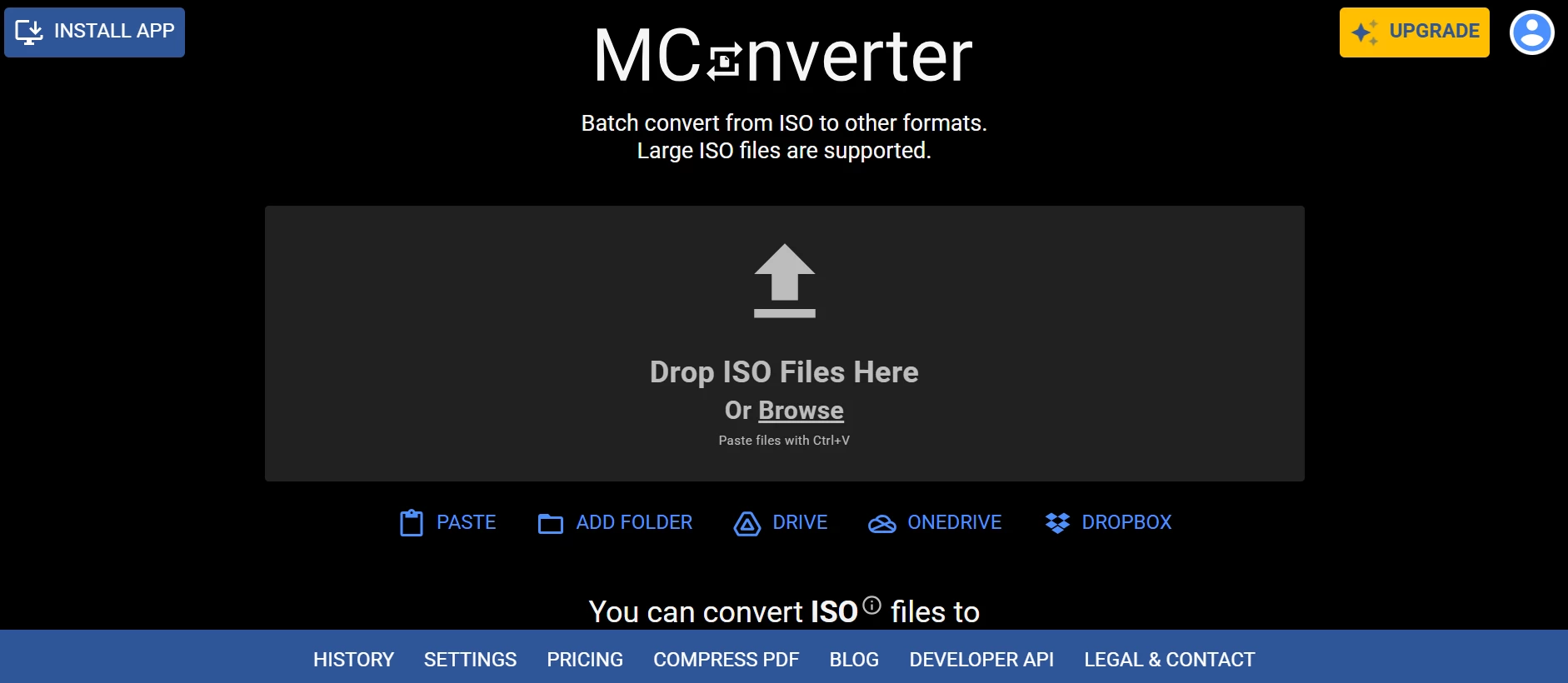
In case of advanced use cases, I occasionally turn to desktop tools like PowerISO, AnyToISO, or WinISO, which offer additional control over compression levels or file splitting. They’re helpful when handling large installation media or system backups that require specific output formats.
Conversion isn’t just about changing extensions, but also it’s about ensuring compatibility across systems. Whether I’m extracting software installers, converting for virtualization, or repackaging old archives, MConverter remains my most reliable and convenient choice for quick, secure conversions.
ISO Files and Security Concerns in 2025#
ISO files are convenient and versatile, but they can also introduce security risks if handled carelessly. I always treat ISO downloads with the same caution as executable files because they can contain scripts, installers, or hidden malware.
As cyberattacks grow more sophisticated, verifying file sources and signatures has become essential in 2025.
I never open ISO files from unverified websites or random email attachments. Attackers often disguise malicious payloads inside ISO images to bypass standard file filters. Once extracted or mounted, harmful scripts can execute automatically, especially on systems with autorun enabled.
Before using an ISO, I scan it with a trusted antivirus tool and verify its checksum or digital signature. Legitimate software vendors typically provide SHA-256 or MD5 hashes on their websites, allowing me to confirm that the file hasn’t been tampered with.
Cloud services and modern browsers have also tightened their protection measures. When I upload or download ISOs through platforms like Google Drive or Dropbox, built-in malware detection runs automatically. It’s still good practice, though, to rescan files after download.
In short, ISO files remain perfectly safe when used responsibly. I only keep copies from trusted developers, verify integrity before mounting, and avoid unnecessary conversions.
How ISO Differs from Other Image Formats#
ISO files continue to play an important role in data management, but cybersecurity in 2025 demands more awareness than ever. Since an ISO can hold installers, scripts, and executable data, it’s often used by attackers to disguise malware or phishing payloads.
I always approach ISO downloads with the same caution as executable files, especially those shared via email or unverified links.
Before using or mounting an ISO, I make a habit of verifying its origin and integrity. Reputable sources usually provide checksums (like SHA-256 or MD5) to confirm authenticity. I also scan files with antivirus software before extracting or running anything. A quick scan saves far more time than dealing with a system compromise later.
I’ve summarized the key security aspects in the table below to show how ISO files compare to other common image and archive formats in 2025.
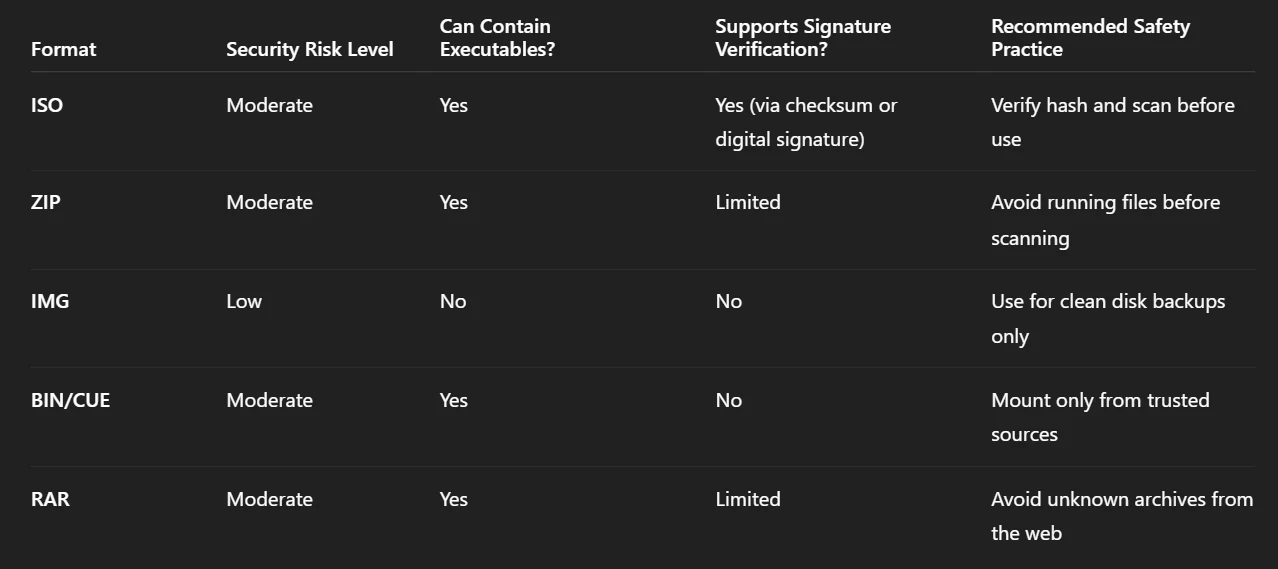
How to Verify ISO Integrity#
Verifying the integrity of an ISO file is something I never skip, especially when downloading operating systems, software installers, or backups. It’s the only way to confirm that the file is complete, authentic, and unmodified. Corrupted or tampered ISO files can cause installation errors or even security risks, so a quick verification is always worth it.
The easiest way to verify an ISO is by checking its checksum, which is a unique fingerprint generated from the file’s data. Most developers share a SHA-256, SHA-1, or MD5 hash alongside their ISO downloads.
After downloading, I generate the same checksum on my system and compare the two values. If they match, the file is safe and intact.
On Windows, I open PowerShell and run: “Get-FileHash C:\path\to\file.iso -Algorithm SHA256”. The output gives me the file’s hash, which I compare with the one listed by the source.
On macOS or Linux, I use: shasum -a 256 filename.iso or sha256sum filename.iso
Both commands generate the same type of fingerprint, allowing me to quickly confirm integrity.
For a simpler option, I recommend MConverter, which automatically verifies files during conversion or upload. It checks for corruption or incomplete data, saving me time when dealing with multiple ISOs at once.
Checksum verification may sound technical, but it’s a habit that guarantees safety and reliability. I never mount or burn an ISO before confirming it’s genuine, because a few seconds of checking can prevent hours of troubleshooting or system damage.
Is It Safe to Download ISO Files From the Internet?#
ISO files are safe to download when they come from verified, official sources. I avoid mirrors or random file-sharing sites since they can host modified or infected images. After downloading, I always scan the file and verify its checksum to ensure it’s authentic and hasn’t been tampered with.
Can I Install Windows From an ISO Without a USB Drive?#
Yes, it’s possible to install Windows directly from an ISO without using a USB drive. I usually mount the ISO in File Explorer, run setup.exe, and follow the installation steps. The system treats the mounted image like a physical disc. It’s quick and works perfectly when reinstalling or upgrading Windows on the same computer.
Why Does My ISO Not Boot Correctly?#
An ISO might fail to boot if it wasn’t created or written properly. I’ve seen this happen when the file is corrupted, missing boot data, or burned using the wrong settings. Recreating the bootable media with a reliable tool like Rufus and verifying the ISO checksum usually fixes the problem.
How Can I Check if an ISO File Is Corrupted?#
I check for corruption by comparing the ISO’s checksum with the one provided by the source. On Windows, I run Get-FileHash -Algorithm SHA256, and on macOS or Linux, I use shasum -a 256. If the values don’t match, the file is incomplete or damaged. Re-downloading it from the official source usually solves the issue.
Is It Legal to Share ISO Files Online?#
Sharing ISO files is legal only when the content is open-source or free to distribute. I avoid uploading or sharing commercial software ISOs, like Windows or paid applications, since they’re protected by copyright. For personal use or backups, it’s fine, but public sharing without permission can violate licensing laws.
How Large Can an ISO File Be?#
An ISO file can reach up to 8.5 GB when created from a dual-layer DVD, but the size depends on the source data. Some Blu-ray ISOs can exceed 50 GB, while custom system images or backups may be even larger. I usually compress or split oversized ISOs to make them easier to store and transfer.
Can I Edit Files Inside an ISO Image?#
Yes, but it requires special software. I use tools like PowerISO, UltraISO, or AnyToISO to add, remove, or modify files inside an ISO. After editing, the image must be saved again to keep it bootable and functional. It’s best to work on a copy rather than the original to avoid file corruption.
The Bottom Line#
ISO files remain one of the most practical and dependable formats for storing, sharing, and installing large collections of data. I use them frequently for operating system setups, backups, and software distribution because they preserve structure, ensure consistency, and simplify management across platforms.
As technology moves away from physical discs, ISO files continue to serve as a digital standard for organization and long-term access. With proper verification, trusted sources, and secure handling, they’re both safe and efficient to use.
Finally, if you are managing system images or working with large-scale data, ISO remains a reliable format that bridges convenience, compatibility, and control - all without the need for physical media.
About the author
Mihael joined MConverter as a co-founder in 2023, bringing a vision to transform a tech tool into a product company built around meaningful user experience. With roots in B2B sales, product development, and marketing, he thrives on connecting the dots between business strategy and customer needs. At MConverter, he shapes the bigger picture - building the brand, inspiring teams, and pushing innovation forward with a can-do mindset. For Mihael, it’s not just about file conversions, but about creating experiences that deliver real impact.
Check out more articles
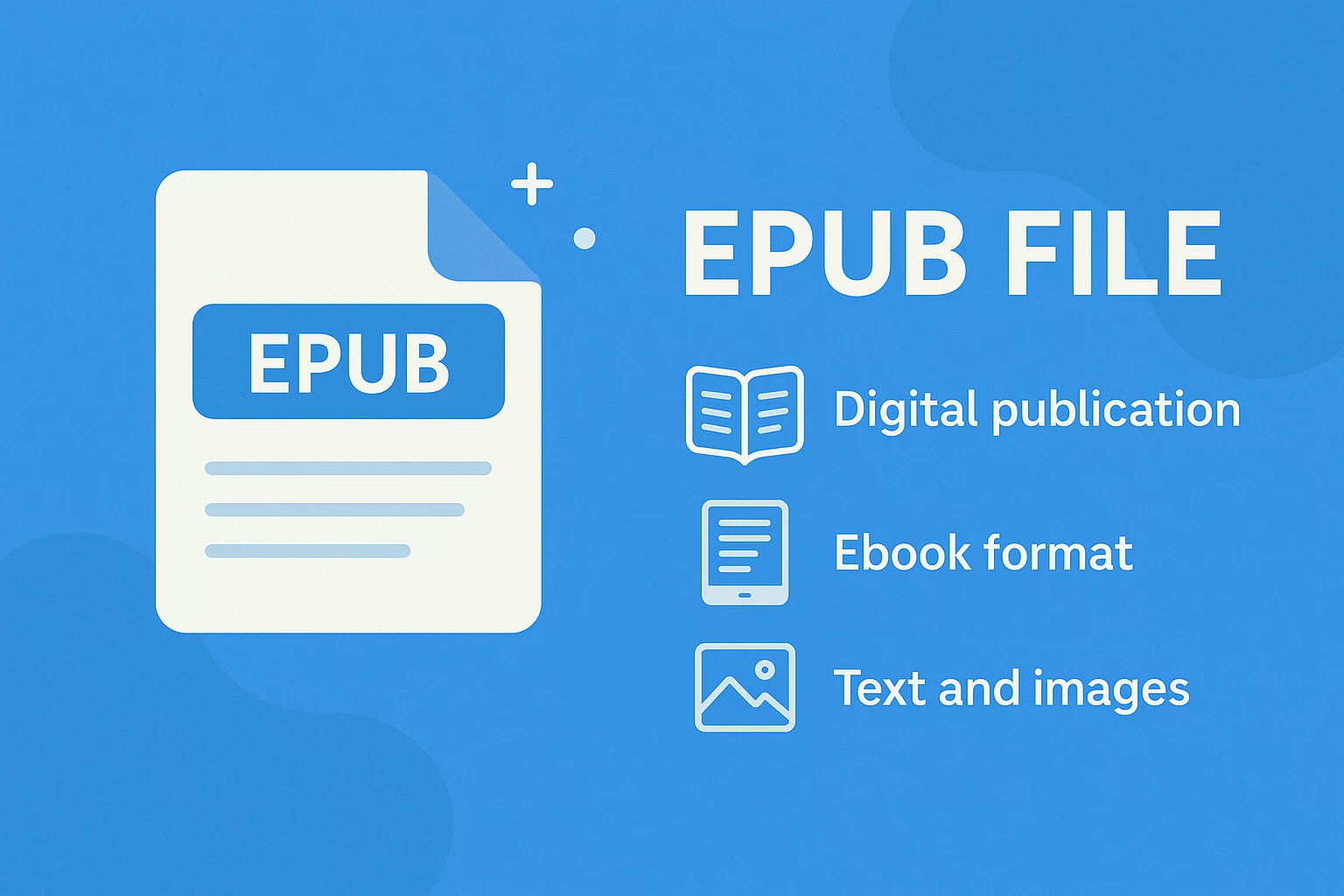
EPUB Files - What They Are & How to Open Them
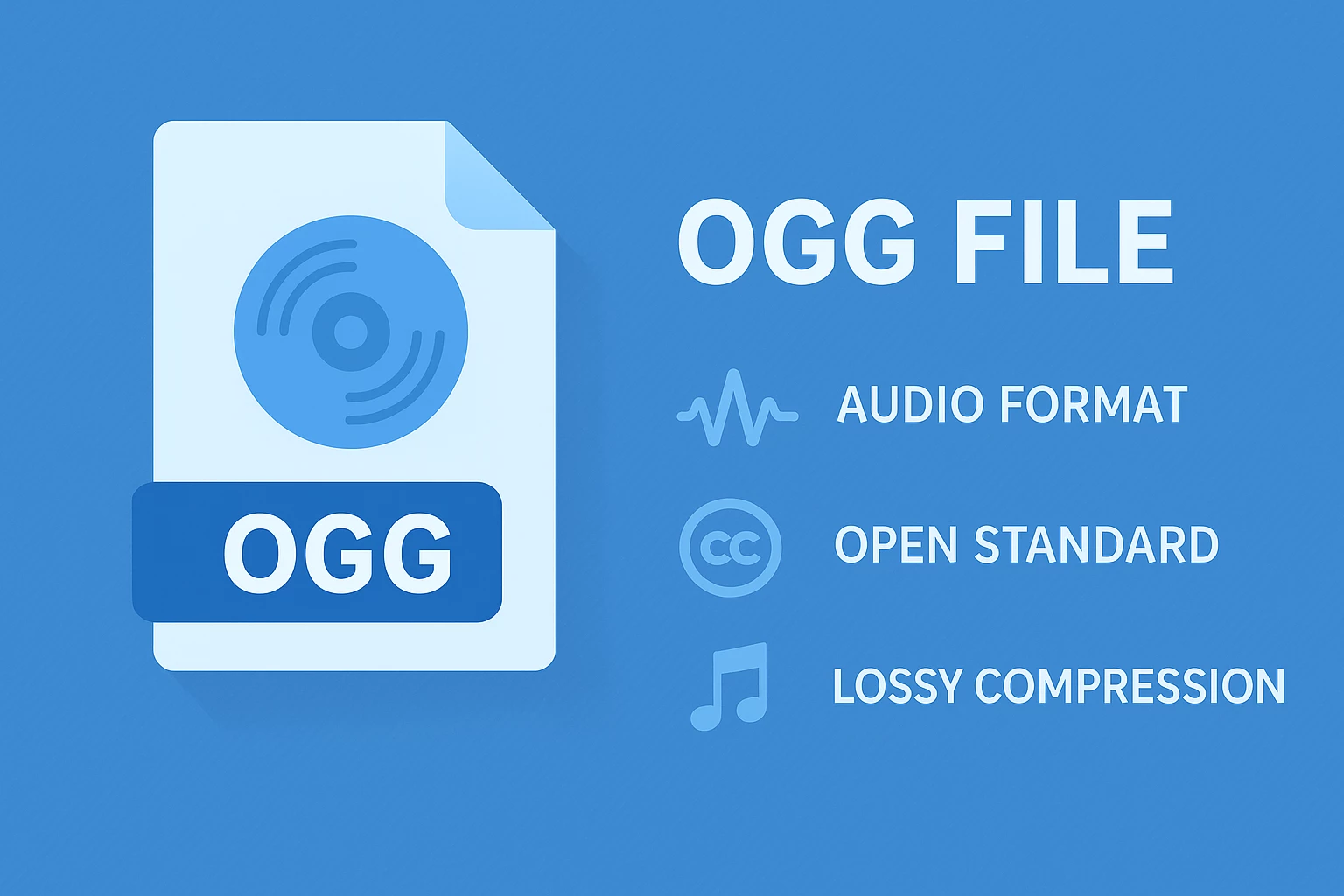
What Is an OGG File? Audio Format Explained
